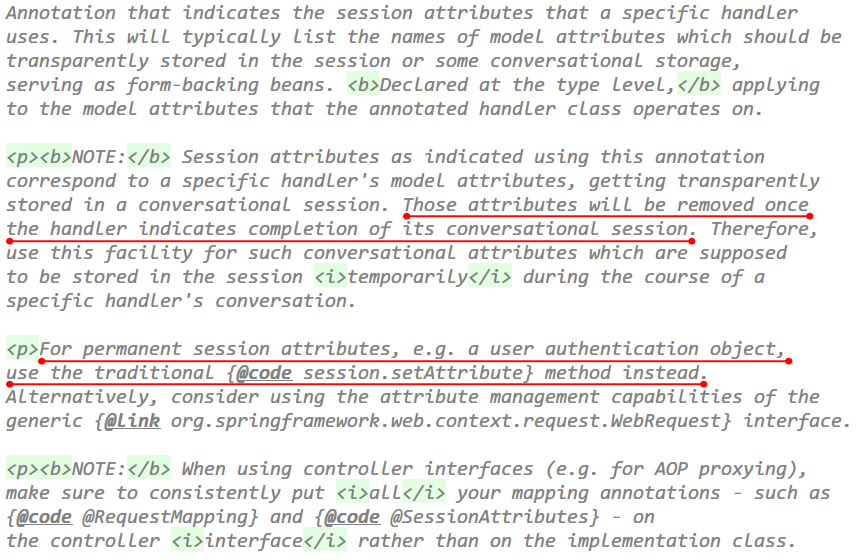一、@ModelAttribute 注解
对方法标注 @ModelAttribute 注解,在调用各个目标方法前都会去调用 @ModelAttribute 标记的注解。本质上来说,允许我们在调用目标方法前操纵模型数据。
1.在 @ModelAttribute 标注的方法处向模型中存入数据
说明一下:在@ModelAttribute 标注的方法处,可以入参的类型和目标方法处允许的入参类型一致,如 @RequestParam 标注的请求参数等等。
有两种方式:
目标方法:
@RequestMapping("/updateStudent")
public String update(Student student) {
System.out.println("student: " + student);
return "success";
}
(1)通过向入参处添加 Model 类型或 Map 类型的参数(不推荐)
@ModelAttribute
public void getStudent(@RequestParam(value = "id", required = false) String idStr, Map<String, Object> map) {
try {
Integer id = Integer.parseInt(idStr);
System.out.println("student id: " + id);
map.put("student", new Student(1, "lisi", 23));
} catch(NumberFormatException ignored) {
}
}
在调用目标方法前,"student" 会被放入到 Model 中。至于说为什么不推荐此种用法,是因为,最终还会向 model 中添加一个 key 为 void,值为 null 的数据。如图:

(2)通过 @ModelAttribute 注解的 value 属性和 @ModelAttribute 标注的方法返回值(推荐)
@ModelAttribute("student")
public Student getStudent(@RequestParam(value = "id", required = false) String idStr, Map<String, Object> map) {
Student student = null;
try {
Integer id = Integer.parseInt(idStr);
System.out.println("student id: " + id);
student = new Student(1, "lisi", 23);
} catch(NumberFormatException ignored) {
}
return student;
}

在调用目标方法前,model 中的数据:
![]()
model 中只有一个键值对。这种写法更加优雅。
总结:SpringMVC 在调用目标方法前,将 @ModelAttribute 注解的 value 属性值作为 key , 返回值作为 value,存入到 model 中。
源码分析:
org.springframework.web.bind.annotation.support.HandlerMethodInvoker#invokeHandlerMethod
public final Object invokeHandlerMethod(Method handlerMethod, Object handler,
NativeWebRequest webRequest, ExtendedModelMap implicitModel) throws Exception {
Method handlerMethodToInvoke = BridgeMethodResolver.findBridgedMethod(handlerMethod);
try {
boolean debug = logger.isDebugEnabled();
for (String attrName : this.methodResolver.getActualSessionAttributeNames()) {
Object attrValue = this.sessionAttributeStore.retrieveAttribute(webRequest, attrName);
if (attrValue != null) {
implicitModel.addAttribute(attrName, attrValue);
}
}
//开始调用标注有 @ModelAttribute 注解的方法
for (Method attributeMethod : this.methodResolver.getModelAttributeMethods()) {
Method attributeMethodToInvoke = BridgeMethodResolver.findBridgedMethod(attributeMethod);
Object[] args = resolveHandlerArguments(attributeMethodToInvoke, handler, webRequest, implicitModel);
if (debug) {
logger.debug("Invoking model attribute method: " + attributeMethodToInvoke);
}
String attrName = AnnotationUtils.findAnnotation(attributeMethod, ModelAttribute.class).value();
if (!"".equals(attrName) && implicitModel.containsAttribute(attrName)) {
continue;
}
ReflectionUtils.makeAccessible(attributeMethodToInvoke);
Object attrValue = attributeMethodToInvoke.invoke(handler, args);
if ("".equals(attrName)) {
Class<?> resolvedType = GenericTypeResolver.resolveReturnType(attributeMethodToInvoke, handler.getClass());
attrName = Conventions.getVariableNameForReturnType(attributeMethodToInvoke, resolvedType, attrValue);
}
if (!implicitModel.containsAttribute(attrName)) {
implicitModel.addAttribute(attrName, attrValue);
}
}
Object[] args = resolveHandlerArguments(handlerMethodToInvoke, handler, webRequest, implicitModel);
if (debug) {
logger.debug("Invoking request handler method: " + handlerMethodToInvoke);
}
ReflectionUtils.makeAccessible(handlerMethodToInvoke);
//调用目标方法
return handlerMethodToInvoke.invoke(handler, args);
}
catch (IllegalStateException ex) {
// Internal assertion failed (e.g. invalid signature):
// throw exception with full handler method context...
throw new HandlerMethodInvocationException(handlerMethodToInvoke, ex);
}
catch (InvocationTargetException ex) {
// User-defined @ModelAttribute/@InitBinder/@RequestMapping method threw an exception...
ReflectionUtils.rethrowException(ex.getTargetException());
return null;
}
}
行号14 处的 for 循环就是处理 @ModleAttribute 标注的方法的,在40行处调用目标方法——在调用目标方法前调用 @ModelAttribute 标注的方法。
在 16 行处已经对请求参数做了一次解析——在@ModelAttribute 标注的方法处,可以入参的类型和目标方法处允许的入参类型一致
20行、25行、31行——第二种方式,同时也明白如果 model 中包含相同的 key 时,是不会替换的。
2.在目标方法处读取模型中的数据
@ModelAttribute("student")
public Student getStudent() {
return new Student(1, "lisi", 23);
}
@ModelAttribute("student2")
public Student getStudent2() {
return new Student(2, "wangwu", 33);
}
(1)在目标方法入参处不使用 @ModelAttribute 注解
@RequestMapping("/updateStudent")
public String update(Student student2) {
System.out.println("student: " + student2);
return "success";
}
控制台输出:
student: Student{id=23, studentName='lisi', age=23}
(2)在目标方法入参处使用 @ModelAttribute 注解
@RequestMapping("/updateStudent")
public String update(@ModelAttribute("student2") Student student2) {
System.out.println("student: " + student2);
return "success";
}
控制台输出:
student: Student{id=23, studentName='wangwu', age=33}
(3)源码分析
org.springframework.web.bind.annotation.support.HandlerMethodInvoker#resolveHandlerArguments
这个方法行数太多了,我们只看关注点:
289行:如果目标方法入参有标记 @ModelAttribute ,获取它 的 value 属性。
else if (ModelAttribute.class.isInstance(paramAnn)) {
ModelAttribute attr = (ModelAttribute) paramAnn;
attrName = attr.value();
annotationsFound++;
}
361行:
else if (attrName != null) {
WebDataBinder binder =
resolveModelAttribute(attrName, methodParam, implicitModel, webRequest, handler);
boolean assignBindingResult = (args.length > i + 1 && Errors.class.isAssignableFrom(paramTypes[i + 1]));
if (binder.getTarget() != null) {
doBind(binder, webRequest, validate, validationHints, !assignBindingResult);
}
args[i] = binder.getTarget();
if (assignBindingResult) {
args[i + 1] = binder.getBindingResult();
i++;
}
implicitModel.putAll(binder.getBindingResult().getModel());
}
不论是对目标方法入参有没有标注 @ModelAttribute 注解,最终都会执行到这里。
看标红的地方:在这里进行解析的。
private WebDataBinder resolveModelAttribute(String attrName, MethodParameter methodParam,
ExtendedModelMap implicitModel, NativeWebRequest webRequest, Object handler) throws Exception {
// Bind request parameter onto object...
String name = attrName;
if ("".equals(name)) {
name = Conventions.getVariableNameForParameter(methodParam);
}
Class<?> paramType = methodParam.getParameterType();
Object bindObject;
if (implicitModel.containsKey(name)) {
bindObject = implicitModel.get(name);
}
else if (this.methodResolver.isSessionAttribute(name, paramType)) {
bindObject = this.sessionAttributeStore.retrieveAttribute(webRequest, name);
if (bindObject == null) {
raiseSessionRequiredException("Session attribute '" + name + "' required - not found in session");
}
}
else {
bindObject = BeanUtils.instantiateClass(paramType);
}
WebDataBinder binder = createBinder(webRequest, bindObject, name);
initBinder(handler, name, binder, webRequest);
return binder;
}
注意:
String name = attrName;
if ("".equals(name)) {
name = Conventions.getVariableNameForParameter(methodParam);
}
如果没有指定,则通过 Conventions.getVariableNameForParameter(methodParam) 获取一个默认值。
if (implicitModel.containsKey(name)) {
bindObject = implicitModel.get(name);
}
从 model中获取,最后执行绑定。
(4)总结:使用在目标方法入参处的 @ModelAttribute 只能起到一个 指定 attrName 的作用,即从 Model 获取数据的 key。
<1>目标方法处的实体形参命名与 @ModelAttribute 方法标注的方法返回值之间没有任何关系,只是类型有关系。
<2>在目标方法入参处不使用 @ModelAttribute 注解的情况:
不需要通过 @ModelAttribute 注解来指定需要使用哪个 @ModelAttribute 标注的方法的 value 属性值。存在多个的话,使用默认值。
<3>在目标方法入参处需要使用 @ModelAttribute 注解的情况:
存在多个 @ModelAttribute 标注的方法,返回值为同一个类型A,且 @ModelAttribute 的 value 属性值不同,在目标方法处,需要以 A 实体作为入参,但是需要不使用默认的 a ,而是需要使用指定
的 a2。这个时候,就需要在目标方法的入参处使用 @ModelAttribute,通过 value 属性来指定使用哪个。
二、@SessionAttribute
1.官方说明

2.对 SessionAttribute 这里有篇帖子总结的非常好,我这里就不再赘述。
http://blog.sina.com.cn/s/blog_6d3c1ec601018cx1.html
3.我自己的理解:
@SessionAttribute 指的是 springmvc 的 session。向其中添加值得时候,同时会向 http session 中添加一条。在 sessionStatus.setComplete(); 的时候,会清空 sprinmvc
的 session,同时清除对应键的 http session 内容,但是通过,request.getSession.setAttribute() 方式添加的内容不会被清除掉。
其他情况下,springmvc session 和 http session使用情况相同。





















 848
848

 被折叠的 条评论
为什么被折叠?
被折叠的 条评论
为什么被折叠?








